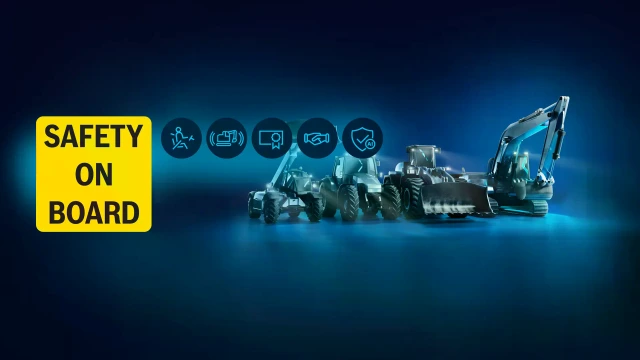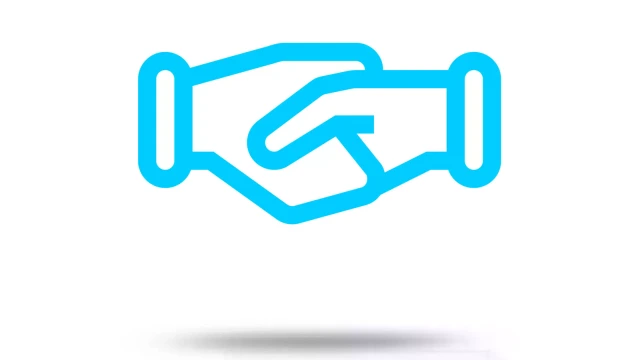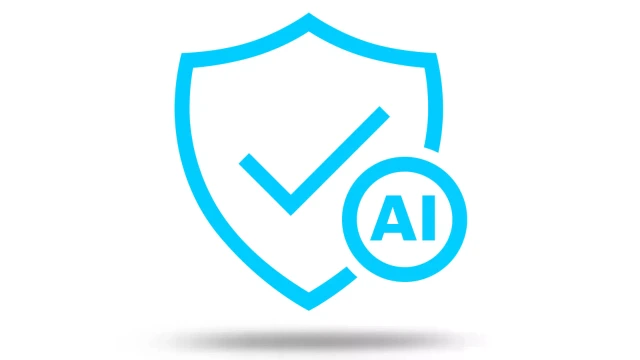



Diverse new regulations and laws, such as the EU Machinery Regulation, present significant challenges for off-highway manufacturers. In the second part of our blog series "Safety, Security, and AI for Mobile Working Machines," we shed light on the most important topics and solution approaches for functional safety, as well as complementary security and AI requirements.
Time is running out: On January 20, 2027, the new EU Machinery Regulation 2023/1230/EU (EU-MR) will replace the previous Machinery Directive 2006/42/EC (EU-MD) – with far-reaching implications for mobile working machines. In this article, you will learn which MR requirements are currently causing OEMs the biggest headaches, how these relate to other changes (e.g., CRA or AI Act), and how you can solve the associated challenges together with Bosch Rexroth.
The 5 most important Functional Safety implications for mobile working machines:
1. Monitoring of restraint systems
2. Monitoring of autonomous machines
3. Annex II list of safety components
4. Overlaps with the Cyber Resilience Act (CRA)
5. Overlaps with the Artificial Intelligence Act (AI Act)

Buckle up, click, safe? Unfortunately, the use of seat belts in off-highway machines is not as self-evident as it is in passenger cars. The EU-MR aims to increase the safety of operating personnel and therefore requires mandatory monitoring of the restraint system. Corresponding functions are intended to ensure that the seat belt is actually used correctly in earthmoving and other mobile working machines at risk of tipping.
Solution Approach: Current BODAS application software solutions are already MR-ready. This allows OEMs to immediately implement the new requirements for monitoring restraint systems or integrate them retrospectively into the series solution via a partial function. The Travel drive control EDA and the Adaptive ground drive AGD also already include the necessary functions for tampering protection. For example, a plausibility check against the seat switch ensures that operating personnel can only move the mobile working machine once they have taken their place in the cabin and the seat belt buckle is engaged.
It is clear that machines working with increasing autonomy, connectivity, and AI support generate risks not fully covered by previous safety concepts. The EU-MR and the AI Act therefore demand special measures to protect employees, passers-by, and objects. To clarify liability issues and understand malfunctions, safety-relevant decision-making processes, events, and errors must be recorded.
Solution approach: In this respect, too, the BODAS Ecosystem from Bosch Rexroth is MR-ready. The BODAS controls and sensors used for assistance functions can also be utilized for monitoring autonomous systems. Through other BODAS solution modules, the collected data can be securely transmitted via established communication channels to higher-level monitoring systems.


As a result of the new Machinery Regulation, all software and systems performing a safety function must be considered safety components and documented in Annex II, the list of safety components. If the function also includes approaches based on machine learning, an external certification body (legally: Notified Body, e.g., TÜV) must be involved in the process to declare conformity. This challenge is even greater because there is not yet a formal process or a harmonized standard.
Solution approach: Also on this point, OEMs are on the safe side with Bosch Rexroth, as the entire BODAS Ecosystem will be ready for use in good time – including development tools, application software, and the BODAS control units of the RC series. Starting in January 2027, Bosch Rexroth will place all EU-MR relevant components as safety components on the market, thereby fulfilling the legally required documentation obligations.
In connected machines, a cyberattack can disable or negatively affect a safety function. Therefore, the two previously separate worlds of cybersecurity and functional safety must seamlessly interlock. The overlaps of the respective requirements from the EU-MR are of high relevance for OEMs, especially since the general topic of security will also be mandatorily regulated by the Cyber Resilience Act (CRA) from November 2027. Among the most important requirements are protective measures against technical compromise and thus securing safety-relevant functions, as well as collecting evidence of software and data changes.
Solution approach: The BODAS Ecosystem is already Security-ready today. For example, the RC40 series of control units is based on established security principles and technologies from the BOSCH Automotive environment. Through an integrated Hardware Security Module (HSM), OEMs have access to ready-to-use security functions, such as Secure Boot, Secure Logging, or Encryption. In total, BODAS, with its hardware and software solutions, covers all aspects of security: from security engineering and implementation to monitoring. The result: a shorter time-to-market with minimal costs – from development and implementation to maintenance in series production.


If OEMs want to use safety functions with artificial intelligence, they must deal not only with the EU-MR but also with the Artificial Intelligence Act (AI Act), which becomes mandatory from August 2027. This is because, according to the AI Regulation (EU) 2024/1689, certain applications are to be considered high-risk AI systems if they are used in safety functions with AI-based algorithms or placed on the market as a safety component within the meaning of the EU-MR. In this case, a dual legal framework with the requirements of both regulations applies. In the field of mobile machinery, this includes, among other things, collision protection solutions with camera-based pedestrian detection.
Solution Approach: With BODAS, off-highway manufacturers are also securely on their way when it comes to AI from the very beginning. All solutions classified as high-risk AI systems will timely meet the joint requirements of the EU-MR and the AI Act. from the date the regulations come into force. Current examples include: the Offroad Robotic Controller ORC2 with integrated AI for partial and high automation of mobile working machines. Or the Collision Avoidance System CAS, which enables effective collision protection through precise object detection and person recognition using radar, ultrasound, or smart cameras. Furthermore, Bosch Rexroth supports OEMs in designing their AI-based applications in compliance with regulations.
The new legal regulations concerning functional safety impose concrete, formal, and ultimately CE-relevant requirements on manufacturers of mobile working machines. Given the tight timeline and high development costs, Bosch Rexroth offers itself as a holistic solution partner, always up-to-date, who thinks along with its customers and unburdens them from the outset from a single source: on the one hand, through the BODAS Ecosystem with its standard-compliant and proven hardware and software modules, and on the other hand, through the industry and technology-experienced Rexroth Support team, which optimally accompanies even MR-relevant projects.
Curious for more?
In the third blog post on Safety, Security, and AI, we will delve into the requirements of the Cyber Resilience Act (CRA) for mobile working machines. Stay tuned to learn how you can efficiently and compliantly strengthen cyber resilience with Bosch Rexroth and the holistic BODAS Ecosystem!
Would you like to learn more about Safety, Security, and AI safety, and exchange ideas with our experts and members of the myBODAS Community?
» myBODAS Platform
All articles from this blog series "Safety, Security, and AI for Mobile Working Machines":
01. Cybersecurity, Functional Safety and AI: What matters now for off-highway manufacturers
02. Functional safety: How OEMs master the requirements of EU-MVO, CRA, and AI Act
03. Cybersecurity: Why OEMs need to act now